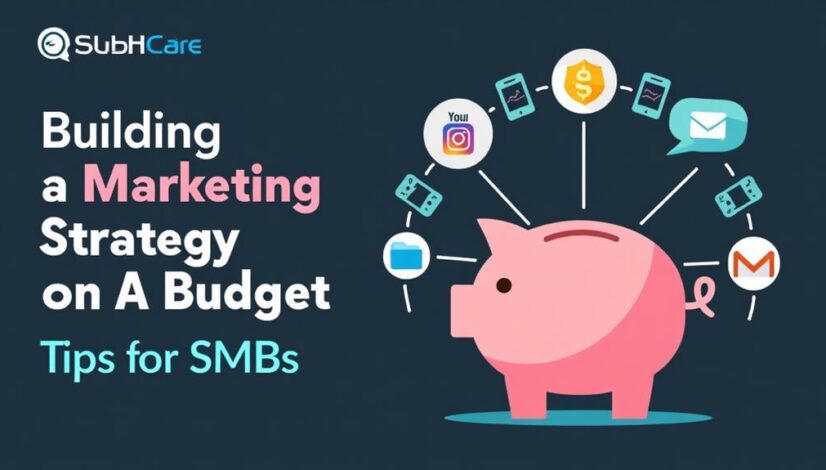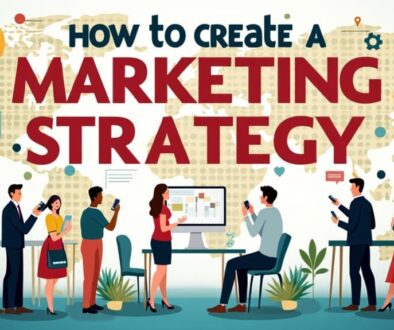Building a Marketing Strategy on a Budget: Tips for SMBs
Building a marketing strategy on a budget requires a focused approach. Start by defining your target audience to guarantee tailored messaging that resonates. Set clear marketing goals to guide your efforts effectively. Utilize social media platforms to enhance visibility, and create valuable content that engages your audience. Implement targeted email marketing for personalized outreach. Collaborate with local businesses for shared resources and greater reach. Optimize your online presence for search engines to attract organic traffic. Regularly monitor your results and adjust strategies as needed, guaranteeing your efforts align with market dynamics. Discover further insights into maximizing budget-friendly strategies.
Key Takeaways
- Define your target audience by analyzing customer demographics and tailoring your messaging to resonate with their needs and desires.
- Set clear, measurable marketing goals to guide resource allocation and align strategies with your overall business objectives.
- Leverage social media platforms by creating quality content that engages followers and amplifies brand visibility with minimal costs.
- Utilize targeted email marketing by segmenting your audience and personalizing campaigns for higher engagement and conversion rates.
- Monitor and analyze results regularly to adapt strategies based on performance metrics and continuously improve your marketing efforts.
Define Your Target Audience

A well-defined target audience is essential for any marketing strategy, especially when operating on a budget. Understanding who your ideal customers are allows you to allocate resources efficiently and tailor your messaging to resonate with their needs and desires. This strategic approach enables you to uncover opportunities that freedom-seeking consumers deeply value, while minimizing unnecessary expenditures.
Customer demographics serve as the foundation for effective audience segmentation. By analyzing age, gender, income, location, and interests, you can create distinct categories that represent various segments of your market. This insight allows you to develop targeted campaigns that speak directly to the motivations and pain points of each group.
For instance, freedom-driven entrepreneurs may respond well to messaging that emphasizes independence and innovation, while budget-conscious families might be more interested in affordability and practicality.
Moreover, accurately defining your target audience enhances your ability to craft tailored content, whether through social media, email marketing, or online ads. Instead of casting a wide net and hoping for results, you can focus your messaging on the segments that align most closely with your value propositions.
This level of precision not only improves engagement but also fosters loyalty among those who feel understood and valued.
Set Clear Marketing Goals
Setting clear marketing goals is essential for maximizing impact on a limited budget. By defining specific objectives, you can focus your efforts on what truly matters, ensuring alignment with your overall business strategy.
Additionally, measuring key performance indicators allows for continuous improvement and informed decision-making, driving better results over time.
Define Specific Objectives
Defining specific objectives is essential for any marketing strategy, especially when operating on a limited budget. A clear set of objectives empowers small and medium-sized businesses (SMBs) to concentrate their limited resources strategically, guaranteeing maximum impact.
Start by utilizing customer segmentation strategies to identify distinct market segments that align with your brand's capabilities. This focus allows you to tailor your marketing messages, ensuring they resonate with your target audience and enhance engagement.
Next, employ objective alignment techniques to guarantee that every marketing goal is interconnected and supports overarching business aims. Specific, measurable objectives create a roadmap for success and provide clarity on what achievements propel your business forward.
This alignment not only simplifies decision-making but also guarantees efficient allocation of your budget towards high-impact initiatives.
Ultimately, clear objectives foster accountability and enable your team to pivot when necessary, maintaining agility in an unpredictable market. By defining specific objectives, SMBs can navigate the complexities of marketing with confidence, driving growth and reaching their true potential without overspending.
Measure Key Performance Indicators
Establishing clear marketing goals is essential for evaluating the effectiveness of your campaigns and ensuring that resources are utilized efficiently. By defining specific Key Performance Indicators (KPIs), you equip your business with the tools necessary to gauge success. KPIs enable you to monitor performance benchmarks against your objectives, giving you a clear view of where to focus your efforts.
Start by selecting KPIs that align with your overall marketing strategy—whether it's lead generation, customer retention, or brand awareness. Analyze current KPI trends relevant to your industry to establish realistic and attainable goals. This data-driven approach empowers you to adapt your tactics in real time, enhancing the agility of your strategies.
Regularly review your KPIs to assess whether you are on track to meet your marketing objectives. This ongoing evaluation will illuminate areas for improvement and help you allocate resources efficiently.
The freedom to pivot based on performance metrics will allow your business to thrive without overwhelming costs, ultimately leading to a more effective budget allocation. Remember, the path to successful marketing hinges on clarity and consistency in measuring what truly matters.
Leverage Social Media Platforms

A well-crafted social media strategy can be a game-changer for businesses operating on a budget. In today's fast-paced digital environment, leveraging social media platforms effectively not only enhances brand visibility but also fosters real engagement with potential customers.
The key lies in understanding current social media trends and how platform algorithms dictate visibility. To maximize your reach, identify which platforms resonate with your target audience. Tailor your approach for each platform while capitalizing on the unique features they offer.
For example, Instagram thrives on visual storytelling, while LinkedIn caters to a professional demographic. By aligning your strategy with the prevailing trends specific to each platform, you can capture the attention of your audience and drive organic growth.
Moreover, staying abreast of platform algorithms is essential. These algorithms determine what content gets seen and by whom. By focusing on quality over quantity—developing authentic connections and encouraging user interaction—you can navigate these algorithms favorably.
Investing time in commenting, sharing, and engaging in conversations will amplify your posts' visibility without the need for a hefty marketing budget.
Create Valuable Content
Value in content creation is paramount for businesses seeking to make an impact without a large budget. By focusing on diverse content types—such as blog posts, videos, and podcasts—you can capture attention and foster audience engagement. Utilizing storytelling techniques is key; compelling narratives resonate with your audience, making your brand memorable and relatable.
To optimize your efforts, consider creating visual content that enhances your message. Infographics and videos can simplify complex information, making it more digestible and shareable. Moreover, incorporating user-generated content not only boosts authenticity but also builds community, encouraging your followers to engage actively with your brand.
Establishing a content calendar is a strategic move that guarantees consistency and enables you to plan around niche topics relevant to your audience. By thoughtfully scheduling content, you can anticipate trends and keep your messaging fresh and aligned with audience interests.
Additionally, prioritize evergreen content that remains relevant over time. This will serve your brand long after its initial publication, continuously driving traffic and engagement.
When you create valuable content with strategic direction, you empower your business to thrive within its unique space. Embrace these strategies to create compelling content that doesn't just communicate but also captivates—giving you the freedom to flourish in a competitive market without excessive spend.
Utilize Email Marketing

Email marketing remains one of the most cost-effective tools available for engaging customers and nurturing leads. Utilizing this powerful medium allows small and medium-sized businesses (SMBs) to connect with their audience on a personal level, driving both conversions and customer loyalty.
To maximize the effectiveness of your email campaigns, implementing robust email segmentation strategies is essential. By dividing your email list into targeted segments based on demographics, purchase history, or engagement levels, you can tailor your messages to resonate with specific groups. This targeted approach results in higher open and click-through rates, as recipients are more likely to engage with relevant content.
Moreover, personalized email campaigns can greatly enhance the customer experience. By addressing your subscribers by name and suggesting products or content aligned with their preferences, you foster a sense of connection that encourages customer retention.
Leveraging data analytics can further refine these campaigns, allowing for real-time adjustments based on how your audience interacts with your emails.
Investing in email marketing not only yields measurable ROI but also empowers SMBs to maintain meaningful relationships without breaking the bank. As you cultivate your email strategy, remember to continuously test and optimize your content, ensuring it remains compelling and aligned with your audience's needs.
Collaborate With Local Businesses
Building relationships with local businesses can greatly enhance your marketing strategy on a budget. Collaborating with other businesses not only expands your reach but also creates valuable community partnerships that foster goodwill and trust.
By strategically leveraging local connections, you can create mutually beneficial marketing opportunities that resonate with your audience. Consider these four tactics to get started:
- Cross Promotional Events: Organize events with one or more local businesses. This enables you to share costs, resources, and audiences—maximizing the impact of each event.
- Bundle Products or Services: Team up with nearby businesses to offer special packages that combine products or services. This approach creates unique value for customers, encouraging cross-promotion between your clientele.
- Social Media Collaborations: Use platforms like Instagram or Facebook to cross-promote each other's content. Tagging local partners opens your brand to new potential customers who are already predisposed to trust nearby businesses.
- Referral Programs: Establish a referral system where local businesses recommend each other's services. This builds community loyalty while introducing your offerings to a wider audience.
In today's competitive landscape, community partnerships and collaborative marketing are not merely advantageous; they are essential.
Optimize for Search Engines

Leveraging local partnerships can enhance your overall marketing strategy; however, expanding your online presence is equally important. One of the most effective ways to do this is through search engine optimization (SEO). By optimizing your website, you increase its visibility, enabling potential customers to find you effortlessly.
Begin with thorough keyword research. Identifying the search terms that your target audience uses will guide your content strategy. Focus on long-tail keywords that reflect your niche and are more likely to convert. Tools such as Google Keyword Planner can aid in this process, allowing you to discover relevant phrases that resonate with your audience.
Next, implement on-page optimization techniques. This involves enhancing various components of your website, including titles, meta descriptions, header tags, and content, to align with your targeted keywords. Guarantee your website architecture is user-friendly, improving navigation and loading speeds, which can lead to higher search rankings.
Consistently publishing high-quality, valuable content that incorporates your keywords will not only attract organic traffic but also establish your brand as a trusted authority in your field.
Moreover, local SEO strategies can maximize your visibility in community searches. Optimize your Google My Business listing and integrate location-based keywords to connect with local customers seeking your services.
Monitor and Analyze Results
Measuring the effectiveness of your marketing initiatives is essential for any business strategy, especially when operating on a budget.
By implementing robust monitoring and analysis methods, small to medium-sized businesses (SMBs) can make informed decisions that maximize their marketing investments.
Below are four practical steps you can take to guarantee your strategies are data-driven and effective:
- Utilize Data Collection Techniques: Choose effective data collection techniques to gather information on customer behavior and campaign performance. Surveys, feedback forms, and website tracking can provide valuable insights.
- Leverage Analytics Tools: Invest in affordable analytics tools that track key performance indicators such as website traffic, conversion rates, and engagement metrics. Tools like Google Analytics can be particularly useful.
- Establish Clear Metrics: Define success metrics based on your business goals. Whether it's lead generation, customer acquisition, or brand awareness, having clear targets allows for focused analysis.
- Evaluate Regularly: Conduct regular evaluations of your marketing performance. Schedule monthly or quarterly reviews to assess what's working and identify areas for improvement.
Adjust Strategies Regularly

In the swiftly changing landscape of digital marketing, flexibility is key to sustaining success. For small and medium-sized businesses (SMBs), the ability to adjust marketing strategies regularly is not just an advantage; it's essential. As market trends evolve rapidly, a static approach can lead to missed opportunities and wasted resources. Embracing flexible budgeting allows for real-time modifications that respond directly to these trends, guaranteeing your marketing efforts remain relevant and impactful.
To effectively adjust your strategies, consistently monitor the performance of your campaigns through analytical tools. This evaluation provides insights into what's working and what isn't, empowering you to make informed decisions.
Regularly review market trends, competitor activities, and consumer behavior to identify shifts that warrant a strategic pivot. Whether it's reallocating funds to more successful channels or exploring new platforms, staying agile is critical.
Moreover, developing a culture of experimentation within your team fosters creativity and innovation. Encourage testing new ideas, messaging, and promotions to discover what resonates with your audience. This not only enhances your brand's visibility but also nurtures a connection with your customers, giving them the freedom to engage with your products or services in a manner that suits them best.
Ultimately, regularly adjusting your marketing strategies guarantees you stay ahead of the curve, offering both the freedom to adapt and the potential for greater returns. Embrace flexibility in your planning process as a core principle that drives long-term success for your SMB.
Frequently Asked Questions
How Can I Market My Business Without Spending Any Money?
Marketing your business without expenses requires ingenuity and strategy. Embrace guerrilla marketing techniques, leveraging creativity to capture attention through unconventional means.
Engage with your community by participating in local events, establishing partnerships with other businesses, and utilizing social media platforms to foster connections.
Encourage customer referrals through word-of-mouth and establish your brand's presence without monetary investment.
With focused efforts, you can effectively increase your visibility and drive growth through innovative, cost-free initiatives.
What Free Tools Can Help With Social Media Scheduling?
In the world of social media, having the right tools can be the key to unblocking success.
Utilize free automation tools like Buffer or Hootsuite to create a content calendar that keeps your posts organized and consistent.
These platforms not only enhance audience engagement through scheduled postings but also offer valuable platform analytics for post optimization.
How Do I Measure the ROI of My Marketing Efforts?
Measuring the ROI of marketing efforts involves analyzing marketing metrics that directly correlate with your investment.
Start by tracking key performance indicators such as customer acquisition cost, conversion rates, and revenue generated from specific campaigns.
Conduct an investment analysis to compare the total marketing spend against returns achieved, ensuring clarity on the effectiveness of each strategy.
This systematic approach empowers decision-makers to optimize budgets and maximize impact, fostering a sense of freedom in resource allocation.
What Are Some Low-Cost Promotional Ideas for Events?
Imagine harnessing the power of community while elevating your event's profile with minimal cost.
By fostering event partnerships, you can share resources and audiences, enhancing visibility. Additionally, engage in community involvement—local sponsorships, collaborations with non-profits, or hosting joint events.
These strategies not only reduce expenses, but also build goodwill and a loyal attendee base.
Utilizing innovative, low-cost promotional ideas can transform your event into a memorable experience without compromising your budget.
Can I Use My Personal Social Media for Business Marketing?
Utilizing personal social media for business marketing can effectively enhance your personal branding while fostering audience engagement.
By sharing authentic content that reflects your professional values and expertise, you build a loyal following.
This blend of personal storytelling and strategic messaging allows you to connect with potential customers on a deeper level.
Ultimately, leveraging your personal platforms can provide the freedom to expand your brand's reach while maintaining an engaging, relatable presence.
Conclusion
In the competitive landscape of small and medium-sized businesses, a well-crafted marketing strategy on a budget can yield significant results. By defining the target audience, setting clear goals, and leveraging various platforms, organizations can maximize limited resources. The journey of building brand recognition and customer loyalty may seem intimidating, but is it not worth the investment when every interaction has the potential to forge lasting connections? Strategic adjustments based on analytical insights guarantee continued relevance and success.




